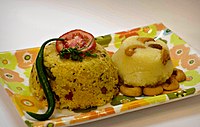Kesari bat
 kesari bath with cashews | |
| Alternative names | ಕೇಸರಿ ಬಾತ್, ரவா கேசரி, రవ్వ కేసరి, रवा केसरी बाथ , റവ കേസരി |
|---|---|
| Course | Breakfast in Karnataka and Northern Tamil Nadu and Kerala, dessert in other places |
| Place of origin | India |
| Region or state | Karnataka, Kerala, Tamil Nadu and Andhra Pradesh |
| Main ingredients | Semolina |
Kesari bat or kesari baat (Kannada: ಕೇಸರಿ ಬಾತ್) is a sweet Indian food that is common throughout the country. The classic ingredients used for its preparation are semolina, sugar, ghee (usually), water, and milk. The sweet is more commonly known as Jonnadula Halwa in certain parts of northern India.
The precise composition of kesari bath varies regionally depending on the availability of ingredients. The dish might be prepared with pineapple,[1] banana, mango, coconut,[2] or rice.[3]
Claims to the origin of the dish are made by Karnataka, Tamil Nadu, and other regions of South India. The dish is common in the cuisine of Karnataka as well as of multiple regions in South India and is a popular dish during festivals such as Ugadi. The word kesari in multiple Indian languages refers to the spice saffron which creates the dish's saffron-orange-yellow-colored tinge.[3] Though it is a sweet dish, in Andhra Pradesh, Karnataka, Kerala and Tamil Nadu, it is prepared not only as a dessert but also for normal breakfasts. It is also served with uppittu or khara bath, and a serving of both dishes on one plate is popularly called "chow chow bath".
In North India, it is served as a sweet dish called suji halwa, suji being the Hindi word for semolina. It uses similar ingredients to kesari baat such as ghee, sugar, semolina and water. Nuts and raisins are often added, and sometimes saffron may also be added. Since this is a household dish in North India, the use of food colour isn't common. It is commonly known as sheera in Marathi/Hindi, rava kesari in Malayalam, Telugu and Tamil, and suji halwa in North India and Bangladesh.
History
[edit]The dish is listed as shali-anna in Manasollasa, a 12th-century work by the Chalukya king Someshvara III.[4]
-
Chow chow bath, a common breakfast in Karnataka, consists of one serving of the spicy khara bat and another of a sweet kesari bath.
-
Kesari bath is traditionally served on a banana leaf in Southern India.
-
Typical Karnataka style lemon coloured Kesari bhath with cashew nuts
References
[edit]- ^ "Pineapple Kesari Bath". Retrieved 13 January 2013.
- ^ "Coconut Kesari Bath". Retrieved 13 January 2013.
- ^ a b "Rice Kesari Bath". Retrieved 13 January 2013.
- ^ "Full text of "Indian Food Tradition A Historical Companion Achaya K. T."". archive.org. Retrieved 2019-01-30.



